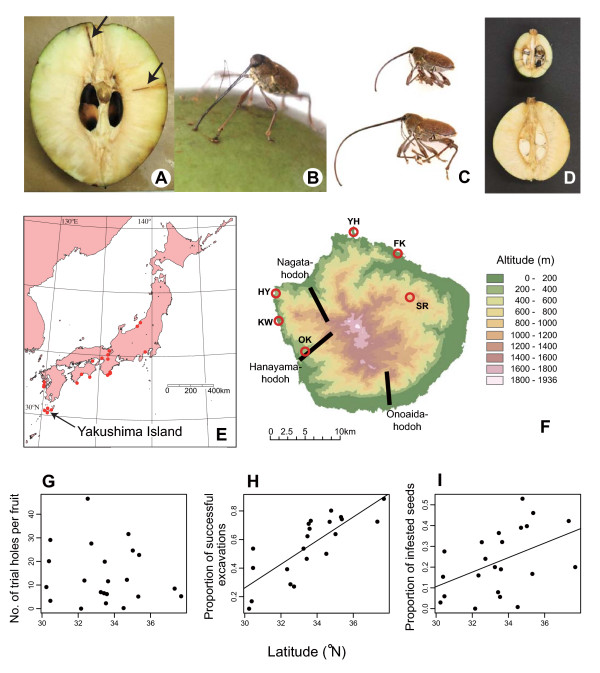Figure 1.
Study organisms and map of study sites. (A) Cross-section of a Japanese camellia fruit showing holes in the woody pericarp made by female camellia weevils (arrows). (B) A female camellia weevil drilling with her long rostrum into a camellia pericarp. (C) Geographic variation in weevil rostrum length. Female weevils from Taiji, Honshu (33.58 °N, 135.96 °E; top) and Hanyama, Yakushima Island (30.38 °N, 130.39 °E; bottom). (D) Geographic variation in camellia pericarp thickness. The dissections of camellia fruits in Kiioshima, Honshu (33.47 °N, 135.86 °E; top) and Shitoko, Yakushima Island (30.44 °N, 130.54 °E; bottom). (E) Study sites in which the latitudinal gradient of the ecological interaction between the weevil and camellia was examined (see -G-I). (F) The topography of Yakushima Island. Six populations in which natural selection acting on camellia pericarp thickness was evaluated and three transects used for testing the altitudinal gradients of the weevil-camellia interaction are shown. See Table 1 for abbreviations of populations. (G) The relationship between latitude and the number of trial holes per camellia fruit made by camellia weevils (y = - 0.810x + 41.3, F1,20 = 0.4, P = 0.54). See Additional file 1 for sampling localities. (H) The relationship between latitude and the proportion of successful excavations of camellia pericarps by camellia weevils (y = 0.0829x - 2.22, F1,19 = 33.1, P < 0.0001). (I) Relationship between latitude and the proportion of camellia seeds infested by camellia weevil larvae (y = 0.0350x - 0.943, F1,20 = 5.4, P = 0.0308).

